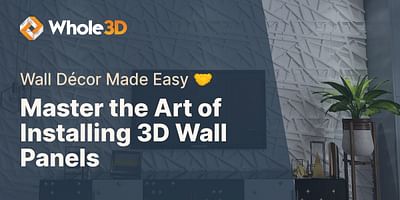Finn Cummings is a seasoned craftsman specializing in carpentry and 3D wall panel installations. With a solid foundation in woodworking and building construction, he has been an indispensable part of the Whole 3D team for over eight years, delivering top-quality installation services to clients.
Hey there! If you're looking to customize your 3D wall panels using Blender's bpy, you've come to the right place. Blender is a powerful 3D modeling software that can help you bring your creative vision to life. With bpy, you can easily design and customize your 3D wall panels to match your unique style and taste. Let me walk you through the process step by step.
First, make sure you have Blender installed on your computer. You can download it for free from the official Blender website. Once you have Blender up and running, follow these simple steps to get started:
1. Import your 3D wall panel model: Start by importing your 3D wall panel model into Blender. You can do this by going to the "File" menu and selecting "Import." Choose the file format that your 3D wall panel model is saved in, such as .obj or .fbx, and select the file from your computer.
2. Explore the bpy interface: Take a moment to familiarize yourself with the bpy interface. You'll find various panels and menus that allow you to manipulate and customize your 3D model. Don't worry if it looks overwhelming at first – we'll take it one step at a time.
3. Modify the materials: To customize the appearance of your 3D wall panel, you'll need to modify its materials. In the bpy interface, locate the "Materials" panel. Here, you can adjust properties like color, texture, and transparency. Experiment with different settings until you achieve the desired look.
4. Add textures: Textures can add depth and realism to your 3D wall panels. In Blender, you can easily apply textures to your model. Go to the "Texture" panel and click on the "New" button to create a new texture. You can then choose from a variety of texture types, such as image textures or procedural textures. Adjust the settings to your liking and see how it transforms your 3D wall panel.
5. Sculpt and shape: If you want to take your customization to the next level, you can use Blender's sculpting tools to sculpt and shape your 3D wall panel. These tools allow you to add details, create textures, and refine the overall look of your model. Experiment with different brushes and techniques to achieve the desired effect.
6. Render your customized 3D wall panel: Once you're happy with your customization, it's time to render your 3D wall panel. In the bpy interface, go to the "Render" panel and choose your desired render settings. You can adjust parameters like resolution, lighting, and camera angle. When you're ready, click on the "Render" button to generate a high-quality image of your customized 3D wall panel.
And there you have it! By using Blender's bpy, you can easily customize your 3D wall panels to match your personal style and create a unique look for your space. Don't be afraid to experiment and let your creativity shine. Happy customizing!
For more tips and guides on installing, designing, and customizing your space with 3D wall panels and decor, be sure to check out Whole 3D. We have a wealth of resources to help you transform your home with our innovative products.















